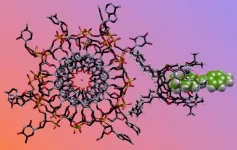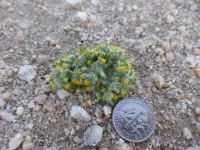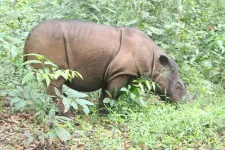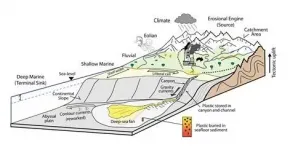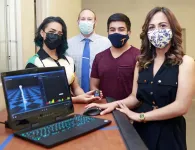(Press-News.org) Small changes in the structure of DNA have been implicated in breast cancer and other diseases, but they've been extremely difficult to detect -- until now.
Using what they describe as a "chemical nose," UC Riverside chemists are able to "smell" when bits of DNA are folded in unusual ways. Their work designing and demonstrating this system has been published in the journal Nature Chemistry.
"If a DNA sequence is folded, it could prevent the transcription of a gene linked to that particular piece of DNA," said study author and UCR chemistry professor Wenwan Zhong. "In other words, this could have a positive effect by silencing a gene with the potential to cause cancer or promote tumors."
Conversely, DNA folding could also have a negative effect.
"DNA folds could potentially keep viral proteins from being produced to minimize immune response," Zhong said.
Studying how these folds might impact living beings, either positively or negatively, first requires scientists to detect their presence. To do that, UCR organic chemistry professor Richard Hooley and his colleagues modified a concept that has previously been used to sense other things, such as chemical components in different vintages of wine.
The chemicals in the system could be designed to look for nearly any kind of target molecule. However, the way the "nose" is typically used, it could not detect DNA. Only once Hooley's group added additional, nonstandard components could the nose sniff out its DNA target.
"Humans detect smells by inhaling air containing odor molecules that bind to multiple receptors inside the nose," Hooley explained. "Our system is comparable because we have multiple receptors able to interact with the DNA folds we're looking for."
The chemical nose is composed of three parts: host molecules, fluorescent guest molecules, and DNA, which is the target. When the desired folds are present, the guest glows, alerting scientists to their presence in a sample.
DNA is made of four nucleic acids: guanine, adenine, cytosine and thymine. Most of the time, these acids form a double helix structure resembling a ladder. Guanine-rich regions sometimes fold in a different manner, creating what's called a G-quadruplex.
Parts of the genome that form these quadruplex structures are extremely complex, though UC Riverside researchers have discovered that their folds are known to regulate gene expression, and they play a key role in keeping cells healthy.
For this experiment, the researchers wanted to demonstrate that they could detect one specific type of quadruplex composed of four guanines. Having done so, Zhong said the research team will try to build on their success.
"Now we think we can do more," she said. "There are other three-dimensional structures in DNA, and we want to understand those as well."
The researchers will examine how forces that damage DNA affect the ways they fold. They will also study RNA folding because RNA carries out important functions in a cell.
"RNA has even more complex structures than DNA, and is more difficult to analyze, but understanding its structure has great potential for disease research," Zhong said.
INFORMATION:
Talking about your bad day at work could lead to great solutions. Cold Spring Harbor Laboratory (CSHL) Associate Professor Saket Navlakha and his wife, Dr. Sejal Morjaria, an infectious disease physician at Memorial Sloan Kettering Cancer Center (MSK), found a way to predict COVID-19 severity in cancer patients. The computational tool they developed prevents unnecessary expensive testing and improves patient care.
Morjaria says, "Generally, I have good intuition for how patients will progress." However, that intuition failed her when confronted with COVID-19. She says:
"When the pandemic ...
Below please find summaries of new articles that will be published in the next issue of Annals of Internal Medicine. The summaries are not intended to substitute for the full articles as a source of information. This information is under strict embargo and by taking it into possession, media representatives are committing to the terms of the embargo not only on their own behalf, but also on behalf of the organization they represent.
1. Increased use of minimally invasive non-endoscopic tests for Barrett's esophagus screening could impact detection and prevention of esophageal cancer
Abstract: https://www.acpjournals.org/doi/10.7326/M20-7164
URL ...
Throughout the history of the West, human actions have often rushed the desert -- and their actions backfired. In the 1920s, the Colorado River Compact notoriously overallocated water still used today by several western states because water measurements were taken during a wet period.
More currently, operators of the massive Ivanpah Solar Electric Generating System in the Mojave Desert are spending around $45 million on desert tortoise mitigation after initial numbers of the endangered animals were undercounted before its construction.
A study published in the journal Ecological Applications from the University of California, Davis, and UC Santa Cruz warns against another potential desert timing mismatch amid the race against climate change and toward rapid renewable ...
The importance of pollinators to ensure successful harvests and thus global food security is widely acknowledged. However, the specific pollinators for even major crops - such as cocoa - haven't yet been identified and there remain many questions about sustainability, conservation and plantation management to enhance their populations and, thereby, pollination services. Now an international research team based in Central Sulawesi, Indonesia and led by the University of Göttingen has found that in fact ants and flies - but not ceratopogonid midges as was previously thought - appear to have a crucial role to play. In addition, they found ...
Today, the Sumatran rhinoceros (Dicerorhinus sumatrensis) is critically endangered, with fewer than 100 individuals surviving in Indonesia on the islands of Sumatra and Borneo. To ensure survival of the threatened species, accurate censusing is necessary to determine the genetic diversity of remaining populations for conservation and management plans.
A new study reported in BMC Research Notes characterized 29 novel polymorphic microsatellite markers -- repetitive DNA sequences -- that serve as a reliable censusing method for wild Sumatran rhinos. The study was a collaborative effort involving the University ...
Boulder, Colo., USA: A new focus article in the May issue of Geology summarizes research on plastic waste in marine and sedimentary environments. Authors I.A. Kane of the Univ. of Manchester and A. Fildani of the Deep Time Institute write that "Environmental pollution caused by uncontrolled human activity is occurring on a vast and unprecedented scale around the globe. Of the diverse forms of anthropogenic pollution, the release of plastic into nature, and particularly the oceans, is one of the most recent and visible effects."
The authors cite multiple studies, including one in the May issue by Guangfa Zhong and Xiaotong ...
UNIVERSITY PARK, Pa. -- As more people go online for shopping, understanding how they rely on e-commerce recommendation systems to make purchases is increasingly important. Penn State researchers now suggest that it's not just what is recommended, but how and why it's recommended, that helps to shape consumers' opinions.
In a study, the researchers investigated how people reacted to two product recommendation systems. The first system generated recommendations based on the user's earlier purchases -- often referred to as content-based recommendation systems. ...
EL PASO, Texas -- For more than a year, researchers at The University of Texas at El Paso's Stanley E. Fulton Gait Research & Movement Analysis Lab in the College of Health Sciences have been using real-time 3D animation to investigate motor impairments in children who have autism spectrum disorder (ASD). Their aim is to understand how children with autism can learn motor skills, so that they can receive effective therapies.
The results of their study, titled "Children With Autism Exhibit More Individualized Responses to Live Animation Biofeedback Than Do Typically Developing Children," were recently published in the journal of Perceptual and Motor Skills. The paper's release coincides with National Autism Awareness Month in April.
"The greatest takeaway from this study is that when teaching ...
UNIVERSITY PARK, Pa. -- Tweaking the look of a social media profile may subtly alter a person's reaction to the health messages that appear on that site, according to researchers. They add that these reactions could influence whether the users heed the advice of those messages.
In a study, the researchers found that people who gained a feeling of control when they customized an online website were more likely to perceive the health message as a threat to their freedom, lowering the chance that they will adopt the message's advice. On the other hand, when customization bolstered the users' sense of identity, they did not resent the message as much and were more willing to consider the ads' recommended behavioral changes, according to the researchers.
"In ...
Ensuring that veterans have stable housing not only reduces homelessness but also slashes the cost of providing them with publicly funded health care, according to a national study led by University of Utah Health scientists. The researchers found that veterans who received temporary financial assistance (TFA) from the Department of Veterans Affairs (VA) to acquire or retain housing had fewer hospital visits and an average reduction in health care costs of $2,800 over a two-year period than veterans who did not receive this benefit.
The researchers say this model could help non-profit organizations and other federal, state, and local governments better serve homeless Americans who are not veterans.
"Getting ...
